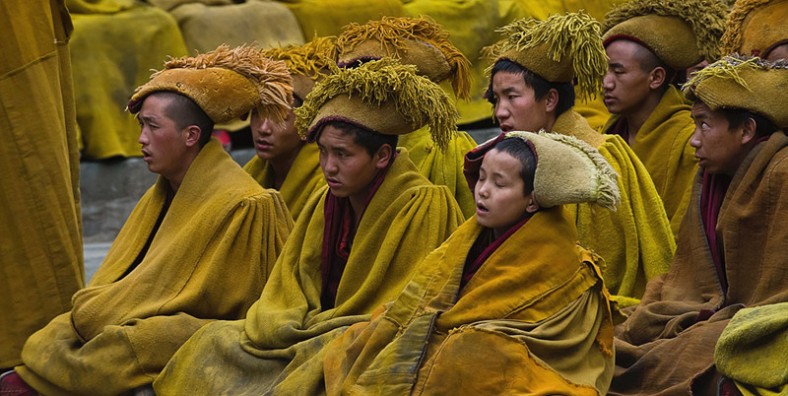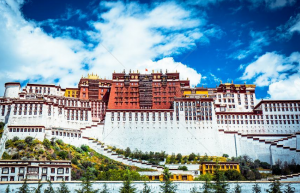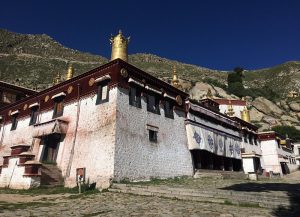
7 Days Gyantse Damar Festival Tour

Tour Overview
If you want to travel to Tibet around June, Gyantse Damar Festival should never be missed. This festival is held in the fourth month of Tibetan calendar( or June...
Code of Tour: YCT0000003172
Length of Travel: 7 Day
Destinations of Tour: Lhasa - Lake Yamdrok - Gyantse - Lhasa
Departure City: Lhasa
Price of Tour: Request
Type of Tour:
Features of Tour: Culture History Landscape Festival
If you want to travel to Tibet around June, Gyantse Damar Festival should never be missed. This festival is held in the fourth month of Tibetan calendar( or June in solar calender) and it can be accessed easily as it overlaps the hot Tibet travel route. You can see the entertaining horse racing, and archery performance and other celebration events.The celebration is expected to last for a week. In this 7 days Gyantse Damar Festival Tour, you will first visit the major monasteries in Lhasa and then head to enjoy the well-known Gyantse-Shigatse loop during which you can join the Damar festival.
Highlights:
- Experience one of the most popular festival in Tibet-Gyantse Damar Festival.
- Experience Tibetan Buddhism in significant monasteries in Lhasa.
- Meet snown mountains, tranquil lakes, shimmering rivers, Tibetan villages and rare animals on your way.
Brief Itinerary
- Day 1: Lhasa Arrival
- Day 2: Lhasa
- Day 3: Lhasa
- Day 4: Lhasa-Gyantse
- Day 5: Gyantse
- Day 6: Gyantse-Lhasa
- Day 7: Lhasa Departure
Google Map
Detailed Itinerary
Day 1 Arrive in Lhasa
Sightseeing and Activities: Arrive in Lhasa
Accommodation:Lhasa
Meals:None
Upon your arrival at Lhasa airport or train station, you will be greeted by your Tibetan guide and escorted to your hotel in Lhasa. Then check in at the hotel, and have a good rest to acclimatize the high altitude. Stay overnight in Lhasa.
Day 2 Lhasa
Sightseeing and Activities:Potola Palace, Jokhang Temple and Barkhor Street
Accommodation:Lhasa
Meals:Breakfast,Lunch

In the morning, we are about to visit the famous Potala palace and explore the grandest of this myriad chapels, and you will experience its audience halls, the jeweled and Golden burial chortens (stupa Tombs) of past Dalai Lamas, and tremendous number of Buddhist frescoes, thangkas, combinations of mandala, etc.
In the afternoon, we will tour the holist temple in Tibet, the Johkang Temple, built during Songtsen Gonpo’s reign by princess Wencheng of Tang Dynasty, 647 A.D, and its famous Barkhor Kora (circling around Jokhang temple and Barkhor street) and bargain with vendors for Tibetan souvenirs on Barkhor street.Stay overnight in Lhasa.
Day 3 Lhasa
Sightseeing and Activities:Lhasa Tour – Drepung Monastery and Sera Monastery
Accommodation:Lhasa
Meals:Breakfast,Lunch

Today, you will visit two important monasteries in Lhasa, the Drepung and the Sera. Drepung Monastery was situated at the foothill of a mountain and was once home to 10000 monks and Ganden podrang in Drepung was famous for its role as the governmental centre during the fifth dalai lama and later was moved to the famous Potala Palace during the fifth dalai lama.
After having lunch, we continue to visit Sera Monastery founded in 1419 by Tsongkapa’s disciple Jamchen Choeje. The most attractive scene is its monk debate held in the debating courtyard mostly around 3 – 5 in the afternoon. Stay overnight in Lhasa.
Day 4 Lhasa-Gyantse
Sightseeing and Activities:Visit Yamdrok-Tso Lake and Pelkor monastery in Gyantse
Accommodation:Gyantse
Meals:Breakfast,Lunch
Drive across Kambala Pass to the dazzlingly turquoise green Yamdrok-Tso Lake, one of the three great holy lakes in Tibet. After having an eyeful of the stunning scenery, move on to Gyantse, one of Tibet’s most traditional towns. En route you will also enjoy spectacular vistas of Karo-la Glacier roadside at 4960m.
Another important attraction for today is Pelkor Monastery, a walled monastery complex in Gyantse. Pelkor monastery is also known for its Kubum, a 35m-high chorten (stupa) with its white layers trimmed with decorative stripes and its crown-like golden dome. Stay overnight in Gyantse.
Day 5 Gyantse Damar Festival and Nomads’ Trade Fair
Sightseeing and Activities:Enjoy Gyantse Damar Festival and Nomads’ Trade Fair
Accommodation:Gyantse
Meals:Breakfast,Lunch
Our focus of today is to enjoy the annual Gyantse Damar Festival lasting from April 15 of Tibetan calendar. Considered to be one of Tibet’s most traditional festivals, it offers us a chance to experience Tibetan Buddhism and folklore in an intimate way. Locals from the 19 townships in the Gyangze County gather to celebrate the festival, which also attracts people from everywhere.
Tourists can enjoy wresting, horse racing, shooting contest, etc. It is not only a folk festival but an exchange with a theme of promoting economy through cultural events like exchanging goods in the trade fair etc.
During the festival, nomads will drive their horse carts to bring their families to the annual festival. Some are fond of races, some like to watch performances, while still others will set up stands to sell home-made sweet milk dregs and other products. But most people will stay in their own tents and enjoy themselves until nightfall.
As tourists explore the exotic trade fair, you can also taste highland Tibetan delicacy and collect exquisite handicrafts and other souvenirs. Stay overnight in Gyantse.
Day 6 Gyantse to Lhasa via Shigatse
Sightseeing and Activities:Gyantse to Lhasa via Shigatse
Accommodation:Lhasa
Meals:Breakfast,Lunch
First follow the Nyang River northwest for an hour or so to Shigatse. On the way , we will stop to tour Shalu Monastery renowned as a center of scholarly learning and psychic training, and its ancient and beautiful mural paintings.
Later, we are going to visit Tashilhunpo Monastery, the seat of Panchen Lama (Tibet’s second highest incarnation).
After lunch, start our drive back to Lhasa along the Sino-Nepal Highway for roughly four hours. Stay overnight in Lhasa.
Day 7 Departure fromL hasa
Sightseeing and Activities:Departure fromLhasa
Accommodation:None
Meals:Breakfast
Transfer to Lhasa airport for your flight back home.
Recommended Hotels
| Destination | 5 Star | 4 Star | 3 Star |
| Lhasa | Luxury St. Regis Lhasa Resort | Lhasa Gang Gyan Hotel | Lhasa Xiongbala Hotel |
| Gyantse | / | / | Gyantse Hotel |
Service Included:
-
Tibet travel permit and all other necessary permits to Tibet;
-
All entrance ticket fees for all tourist sites listed in the itinerary;
-
Personal knowledgeable English-speaking Tibetan local tour guide;
-
Personal comfortable, clean and safe vehicle with reliable Tibetan local driver; vehicle ranging from 4WD land cruiser to minibus depending on your group size;
-
All lodging listed in the itinerary; it’s your decision about the accommodation class: luxury 5-star international hotel, comfortable 4-star hotel, economic 3-star hotel or budget hostel, guesthouse or tent. Please tell us your accommodation preference when submitting the enquiry; we will arrange the best-value hotels for you.
-
Domestic flight/train tickets listed in the itinerary;
-
All meals listed in the above itinerary.
Service Excluded:
-
International flight to and out of China;
-
Chinese visa (Note: we could help you with the Chinese visa application, like providing the invitation letter, presenting the hotel or domestic flight reservation copies, etc that you may need. )
-
Domestic flight/train not listed in the itinerary. (We can provide you the domestic flight/train ticket booking service at the BEST discount price; please contact us our travel experts for the details.)
-
Meals not specified in the itinerary; usually it costs about USD3-15 per person for one meal in TAR (Tibet Autonomous Region).
-
Tips and gratitude to tour guide and driver;
-
Personal expenses, like laundry, phone call, snacks, soft drinks (please do the best to avoid the alcoholic beverages during your Tibet trip), optional tour activities, etc.
Travel Tips:
- Tibet Permits
There are several permits required to visit Tibet. Tibet Entry Permit, issued by Tibet Tourism Bureau, is the most important one which has to be obtained before your trip because you must have it to take your flight/train to Tibet. To get the permit, you have to book a Tibet tour with us, and send us your passport and Chinese visa about 20 days in advance, and then let us apply for the permit (all Tibet permits can only be applied by travel agency). If you travel to other prefectures like Shigatse, Nyingchi, Shannan, etc, you also have to obtain an Alien Travel Permit. If you travel to Mount Everest, you have to obtain a Border Permit. (Tibet Discovery, with office in Lhasa, has always kept up with the latest news on Tibet Permits. Traveling with us, all your permits are guaranteed as long as you are qualified to the requirements.)
- Available Months to Visit Tibet
Generally speaking, May to early October is the best time to for a Mount Kailash trip. July and August are the peak season and rainy season. It may be too cold to travel in Kailash area from November to March. There is usually heavy snow. The conditions in Namtso Lake and Mount Everest area are quite similar with Kailash. While other places like Lhasa, Gyantse and Shigatse are suitable for travel all year around.
- High Altitude Sickness
The average altitude of Tibet is about 4000 meters above the sea level (Lhasa: 3700m; EBC: 5200m; Namtso: 4718m). You may suffer a bit from High Altitude Sickness in the beginning days of your Tibet trip if you haven’t had rich high plateau travel experience. But don’t worry too much, the high altitude can be acclimatized usually in 2~3 days. Our suggestion is to take a physical examination and get suggestions from your doctor, and also bring some medicines to prevent from High Altitude Sickness before your trip. While in Tibet, you should keep warm all the time, avoid strenuous activities, drink more water and eat more vegetables and carbohydrates. You’d better not take showers during the first two days after your arrival at Tibet. If you don’t feel well, get help from your tour guide or go to the hospital without any delay.
- How to Go to Tibet
Basically you have two options – flight and train. Currently, you can take a flight to Lhasa from Beijing(4.5hrs), Xian(3.7hrs), Chengdu(2.5hrs), Chongqing(3hrs), Kuming(3hrs), etc. Among all these cities, Chengdu and Xian have more frequent flights to Lhasa. Kathmandu also has several flights to Lhasa each week.
If you a train travel, you can take a train to from Beijing(40.5hrs), Xian(32hrs), Chengdu(43hrs), Shanghai(47hrs), Chongqing(42hrs), Lanzhou(25hrs), Xining(22hrs), Guangzhou(54hrs).
- Packing and Wearing Ideas
Firstly you can’t forget your passport and Chinese Visa. A large backpack and a smaller one are recommended (the smaller one can be used for daily activities). Also bring the necessary medicine you need. Other stuffs like sunglasses, snow glasses, hats, lip balm, sun block are recommended. As for wearing, you are suggested to dress in layers (both thin and thick jackets). Down jacket is necessary in Spring and Autumn. A pair of durable and comfortable shoes is necessary.


















hello we wanted information to coincide with the Gyantse 2020 festival, on what date is this summer celebrated?
are there yaks races?
Dear Jaume
Thanks for your inquiry.
The Gyantse Damar Festival is usually held in fourth lunar month of the Tibetan calendar.It falls around 20 of July, 2020. You could see wrestling, track and field events, and ball games, Horse race etc. But no yak race.